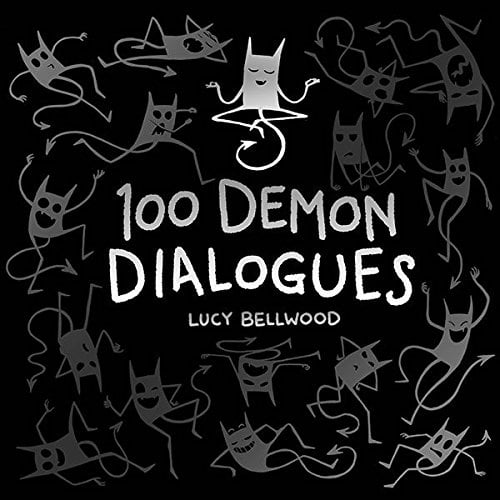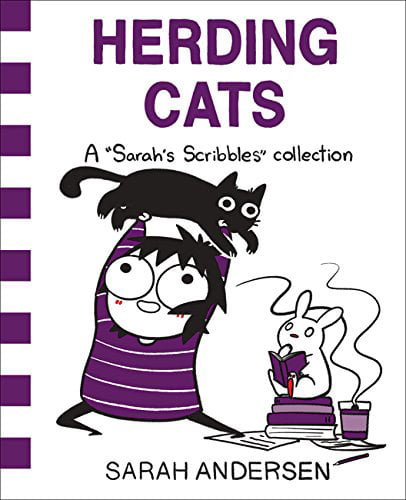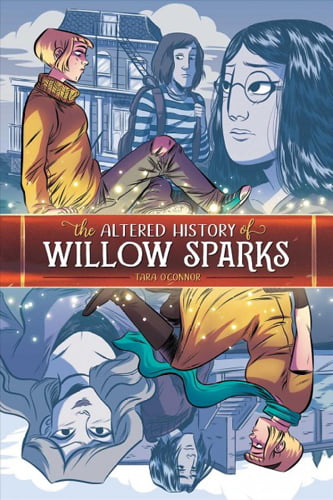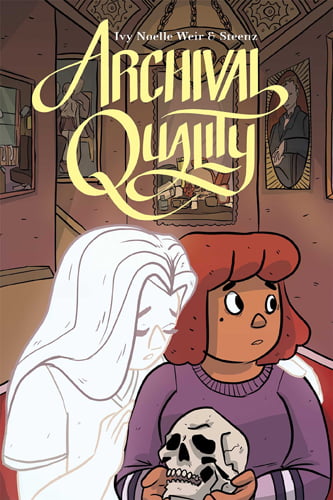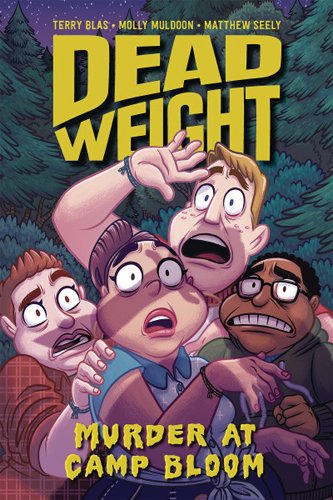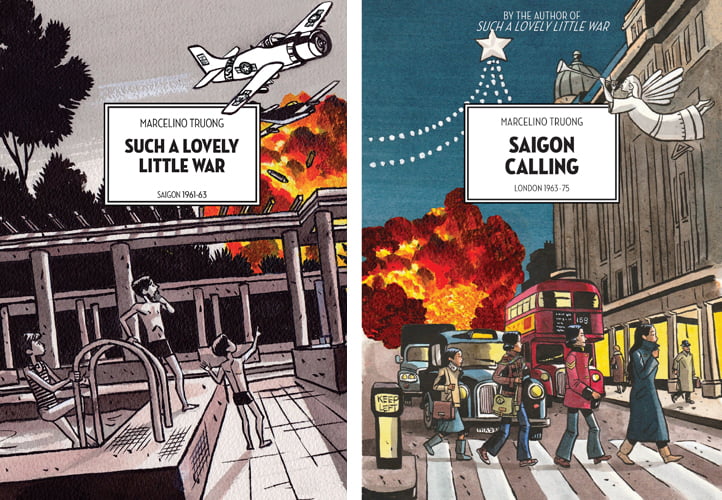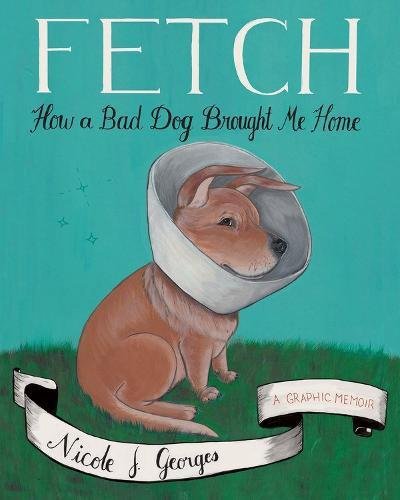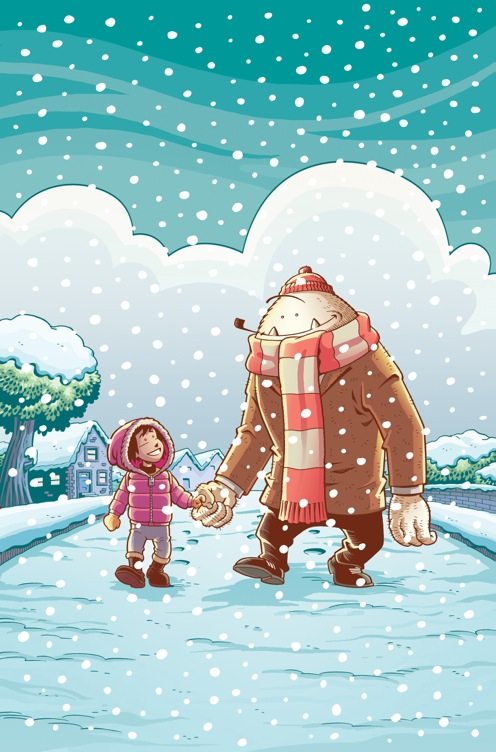 Following up with my two recent columns about comics for kids, this week’s Stack Overflow includes comics that are for older kids and adults. I’d classify most of these as young adult and up, mostly for content, though there are a few that are okay for younger readers—they just may not have the shared experience yet to really appreciate them.
Following up with my two recent columns about comics for kids, this week’s Stack Overflow includes comics that are for older kids and adults. I’d classify most of these as young adult and up, mostly for content, though there are a few that are okay for younger readers—they just may not have the shared experience yet to really appreciate them.
100 Demon Dialogues by Lucy Bellwood
I met Lucy Bellwood a few years ago when she was doing live drawings of the speakers at a local conference and I happened to sit near her. I loved watching the process, seeing the speakers appear on the page, along with a few choice quotes from their talks. A year later, Bellwood gave her own XOXO talk, about being an artist and publishing a book and being broke. It was powerful and vulnerable: many creatives recognized the same struggles, while those in other industries were surprised to hear how hard it can be to earn a living with your art.
Last year, Bellwood ran a Kickstarter campaign to publish a book of cartoons from her 100 Day Project, in which she drew daily cartoons featuring her demon: a little pointy-eared devil that constantly berated her for being selfish or untalented, or worried about never finding success, and so on. This little demon had popped up in her Inktober drawings in prior years, but her 100 Day Project really focused on facing the demon.
I backed the Kickstarter project myself, but it will soon be available to purchase if you missed the campaign. While I don’t have all the same struggles as Bellwood does, many of the comics really resonated with me. The literal depiction of a demon gives a voice to her doubts and personifies them, but also allows her to engage it and argue with it. As it turns out, the demon isn’t always bad, either: it wants what’s best for you, but often acts out of fear. As Bellwood explains in the afterword, it’s important to realize that your demons aren’t the whole of you, but they are a part of you.
While this book is mostly safe for kids, it’s hard to know how much it will really make sense to younger kids who don’t have struggles with self-doubt. However, I think it will really strike a chord with those who make art, young and old. (And there are also very cute demon plushies, too.)
Herding Cats: A “Sarah’s Scribbles” Collection by Sarah Andersen
This book has a similar feel, though a different approach. I’ve often seen Sarah Andersen’s comic strips shared on Twitter, but I hadn’t ever sat down and read a bunch of her comics all at once until this one arrived in the mail. It’s her third published collection of comics. The comics feature a big-eyed, cartoony version of Sarah, putting her quirks and foibles on display for our entertainment: her anxieties, her reliance on coffee, her procrastinating. But Andersen isn’t just making fun of herself—she’s showing her readers how universal these struggles are, and making it okay to talk about them.
The book ends with a section called “Making Stuff in the Modern Era: A Guide for the Young Creative” that isn’t just comics—it’s more like an essay, with comic illustrations. Andersen dives into making things and sharing them online, particularly the way that it exposes you to harassment and trolls, and how hard it can be to keep making stuff when you feel like the online world is a big dumpster fire. Her comics here are both funny and painful, but ultimately she offers a lot of encouragement and advice on growing pains and handling criticism. For anyone who creates things and battles insecurity and imposter syndrome, this book helps you feel that you’re not alone out there.
The Altered History of Willow Sparks by Tara O’Connor
What teenager doesn’t have things in their life they wish they could change? Embarrassing situations, inconvenient pimples, unpopularity … the list goes on. Willow Sparks, a nerdy girl who gets picked on by some of the popular kids, gets a chance to rewrite her history—literally—thanks to a mysterious book she finds in the library. She finds herself hanging out with the cool kids, partying with a boy she likes, but also drifting away from her friend Georgia. And, as Willow soon discovers, using the book has some side effects.
This book reminded me a little bit of Bryan Lee O’Malley’s Seconds, another comic book about a magical ability to change the past, though in Altered History it doesn’t rewrite everyone’s memories, which makes things a little trickier for Willow. It’s certainly a cautionary tale, and although the moral of the story—to be happy with the life you live—is perhaps a little cliched, I enjoyed the journey to get there.
Archival Quality by Ivy Noelle Weir, illustrated by Steenz
The Logan Museum is a bit strange—it had been a hospital, orphanage, and sanatorium in its past, and some say that it’s haunted. When Cel Warden gets a job there as an archivist, things seem a little strange and just get stranger. While processing materials in the archive, Cel discovers evidence about a mysterious woman who was treated for mental illness long ago. The woman seems to be reaching out to her, causing weird things to happen in the library, and Cel finds herself missing hours of her life. But why? The story deals a bit with Cel’s own depression and anxiety, and also digs into the horrific treatments that were used for mental illness in the past: it’s both about finding peace for a ghost and for Cel herself.
Dead Weight: Murder at Camp Bloom by Terry Blas and Molly Muldoon, illustrated by Matthew Seely
Camp Bloom is a weight-loss camp, and many of the teens are there against their will—no candy, plenty of exercise, and no cell phones. It looks like it’s going to be a grueling, boring summer. But then two of the kids (while sneaking into the woods for a candy bar) witness the murder of one of the camp counselors, and now all the camp staff are suspects. A group of four teens investigates, and they discover that everyone has some secrets. The question is: who would kill to keep theirs?
One thing I found was that the book’s setting is handled well, with a variety of characters who are at Camp Bloom for various reasons, with voices that speak up for positive body image and a wide range of body types represented. Aside from the central murder mystery plot, there are moments where the characters talk about what it’s like to feel pressured to conform to a particular image. I’m not sure how I feel about the murderer’s motivations, when they were finally revealed … but I can’t really discuss that as much without giving away the answer. Still, the story definitely kept me guessing until then.
Such a Lovely Little War and Saigon Calling by Marcelino Truong
These two comic books delve into the Vietnam War, from the perspective of a French-Vietnamese boy who came of age age during the turmoil. Marco Truong was the son of a Vietnamese ambassador, and his family moved to Saigon at the outset of the war, when he was still very young. His French mother suffered from bipolar disorder—though that illness wasn’t well understood at the time—and living in a war zone exacerbated it.
Truong’s books are fascinating in their breadth: he shares his own small, private moments with his family and friends, but also digs into the history and politics of the war. I realized how little I knew about the Vietnam War while reading these books—particularly from Truong’s perspective: his family was South Vietnamese and resisted the Communists, and resented being portrayed as “puppets” of the United States. Although Truong is critical of North Vietnam and the Viet-Cong, he also acknowledges South Vietnam’s missteps, and the way that their cause was not widely understood.
In 1963, the family moved to London, so they were no longer directly impacted by the war, but because of family and friends, they were still very much concerned about what was happening in Vietnam. Truong captures what it was like growing up in the ’60s in London—Beatlesmania, hippies, the anti-war movement—while depicting the horrors that were happening in Vietnam. It’s a deeply personal book that was really eye-opening, and definitely shows a side of the Vietnam War that I hadn’t seen before. My only complaint is that sometimes it the order of panels or speech bubbles felt mixed up because of the way they were placed, but it usually wasn’t too hard to figure it out eventually. I would pair this with Thi Bui’s The Best We Could Do, another personal recounting of the Vietnam War (mentioned in this Stack Overflow).
Fetch: How a Bad Dog Brought Me Home by Nicole J. Georges
While we’re talking about memoirs, here’s another one, albeit with a very different setting. Nicole Georges (the author of the graphic memoir Calling Dr. Laura) recounts her life with Beija, a rescue dog who was very particular about, well, everything. Young Nicole had adopted Beija as a gift for her boyfriend … only to be told by his parents that they wouldn’t allow him to keep the dog. So Nicole was stuck with Beija, which resulted in a lot of moving, attempts to get rid of the dog, and managing housemates so that they wouldn’t set off Beija’s alarm bells.
It’s also a story about Georges herself—moving out of her parents’ home while she was still in her teens, finding her way to Portland, Oregon, and figuring out what to do with her life, all while managing a difficult dog.
Dead of Winter: Good Good Dog by Kyle Starks, illustrated by Gabo
And now for a story about a good dog—though not a real one.
If you’re familiar with the zombie board game Dead of Winter, you’ll recognize Sparky, a dog who happens to be a playable character in the game. This comic book features Sparky and a host of other characters from the game—though Sparky is definitely the center of the story, with occasional flashbacks about his former life. Sparky was a stunt dog before the zombiepocalypse, playing a superhero dog—and now he hates zombies (and is fortunately immune to the virus).
This comic is definitely aimed at older teens and up: there’s a lot of violence and gore (as you’d probably expect from a zombie story), plus a lot of strong language. It also has a lot of humor in it: it’s not a straightforward horror story. I wasn’t a huge fan of the artwork but it was an entertaining story, and if you like Dead of Winter you may enjoy this deeper foray into one potential plotline from the game.
The Damned, Volume 2: Ill-Gotten by Cullen Bunn, illustrated by Brian Hurtt with Bill Crabtree
I mentioned the first volume of The Damned in my spotlight on Oni Press, and this volume picks up a little after the first one left off. Eddie is a mortal, but he’s got a curse: he can’t die. Or, at least, he doesn’t stay dead. The first person who touches him after his death takes his wounds and Eddie comes back to life.
In this volume, Eddie is just trying to enjoy his life running the Gehenna Room, a fancy nightclub that doesn’t allow demons. But then an old pal shows up, hiding something that all the demons are after, and Eddie finds himself once again in the thick of it all, full of double-crosses and curses and contracts. If you like hard-boiled crime stories with a good dose of the supernatural, this one fits the bill.
You Have Killed Me by Jamie S. Rich, illustrated by Joëlle Jones
And here’s another murder mystery with damaged guys and deadly dames—though this time without the demons. Why is it that the private eyes always get mixed up with the women who come to them for help? Well, in this story the private eye is Antonio Mercer, and his latest client is Jennie, who happens to be the sister of his former lover Julie. Julie has disappeared from a locked room without a trace, shortly before she was supposed to get married. When Mercer starts digging into the case, though, he finds connections to the mob and secret relationships, and things get more and more tangled up. This story is definitely in the mold of classic detective noir, with a high body count and lots of tough talk.
My Boyfriend Is a Bear by Pamela Ribon, illustrated by Cat Farris
Nora just hasn’t had any luck finding the right guy … but then one day she meets a bear while hiking, and decides, what the heck—he can’t be any worse than the other guys she’s dated, right? This comic book is surreal and silly, but also very sweet. Nora’s struggles to win over her friends and family are hilarious, and the bear is considerate, sweet, and has a pretty limited vocabulary. But winter is coming, and the bear is going to go hibernate for a few months—will their relationship survive such a long time apart? My Boyfriend Is a Bear is a goofy romantic comedy, and the illustrations are delightful. While it does have some innuendo and implications, there’s nothing explicit, so I would say it’s fine for young adults.
My Current Stack
Other than polishing off the comics here, I’ve been continuing to make my way through Dictionary Stories, and trying very hard to resist the temptation to crack the cover of The Art of Incredibles 2, which just arrived this past week. I’m so excited for the movie and I don’t want to see any spoilers ahead of time, so I’ll be saving this one until June. The cover looks nice, though! I also just started reading Best of Enemies, a three-volume comic book series about the history of US and Middle East Relations. Like Truong’s books, it’s fascinating and informative.
Disclosure: I received review copies of these books, except 100 Demon Dialogues, which was my own purchase.
